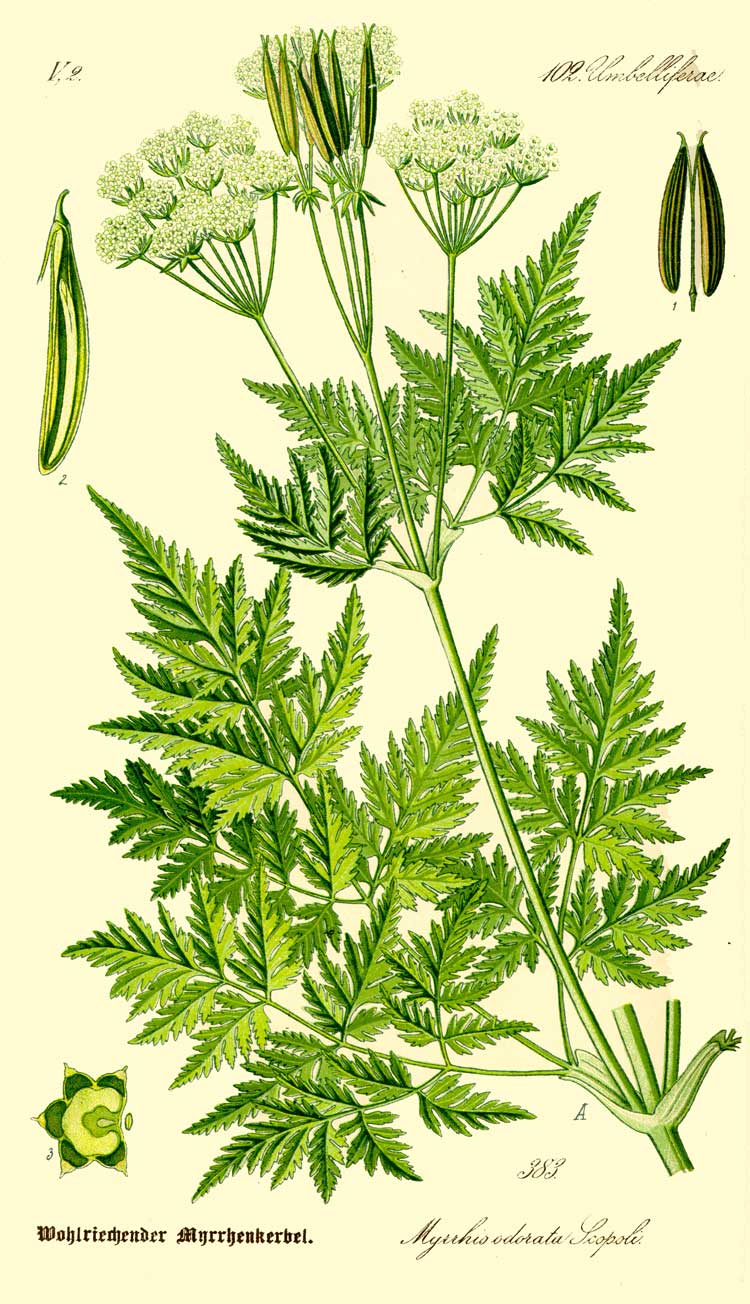
Myrrhis odorata (*)
Classification System: APG IV
Superregnum: Eukaryota
Regnum: Plantae
Cladus: Angiosperms
Cladus: Eudicots
Cladus: Core eudicots
Cladus: Asterids
Cladus: Campanulids
Ordo: Apiales
Familia: Apiaceae
Subfamilia: Apioideae
Tribus: Scandiceae
Subtribus: Scandicinae
Genus: Myrrhis
Species: Myrrhis odorata
Name
Myrrhis odorata (L.) Scop. (1771)
Synonyms
Basionym
Scandix odorata L., Sp. Pl. 257 (1753).
Homotypic
Chaerophyllum odoratum (L.) Lam., Fl. Fr., 3: 439 (1779).
Chaerophyllum odoratum (L.) Crantz, Cl. Umbell. Emend. 75 (1767).
Lindera odorata (L.) Asch. in Asch. & Graebn., Fl. Nordost. Deutsch. Flachl., 536 (1899).
Heterotypic
Myrrhis odorata subsp. sulcata (Lag.) Nyman, Consp. Fl. Eur. 299 (1879).
Myrrhis sulcata Lag., Elench. Pl. 13 (1816).
Selinum myrrhis E.H.L.Krause in Sturm, Fl. Deutschl., éd. 2, 12: 68 (1904).
Distribution
Native distribution areas:
Continental: Europe
Albania, Austria, France, Germany, Switzerland, Spain, Andorra, Italy, former Yugoslavia, Slovenia, Croatia, Czech Republic, Slovakia
References: Brummitt, R.K. 2001. TDWG – World Geographical Scheme for Recording Plant Distributions, 2nd Edition
References
Scopoli, J.A. 1771: Fl. Carniol., ed. 2, 1: 207.
Links
Hassler, M. 2018. Myrrhis odorata. World Plants: Synonymic Checklists of the Vascular Plants of the World In: Roskovh, Y., Abucay, L., Orrell, T., Nicolson, D., Bailly, N., Kirk, P., Bourgoin, T., DeWalt, R.E., Decock, W., De Wever, A., Nieukerken, E. van, Zarucchi, J. & Penev, L., eds. 2018. Species 2000 & ITIS Catalogue of Life. Published on the internet. Accessed: 2018 Sep 01. Reference page.
International Plant Names Index. 2018. Myrrhis odorata. Published online. Accessed: Sep 01 2018.
The Plant List 2013. Myrrhis odorata in The Plant List Version 1.1. Published on the internet. Accessed: 2018 Sep 01.
Tropicos.org 2018. Myrrhis odorata. Missouri Botanical Garden. Published on the internet. Accessed: 2018 Sep 01.
USDA, ARS, Germplasm Resources Information Network. Myrrhis odorata in the Germplasm Resources Information Network (GRIN), U.S. Department of Agriculture Agricultural Research Service. Accessed: 07-Oct-06.
Vernacular names
Deutsch: Süßdolde, Myrrhenkerbel
English: Cicely
español: Perifollo Oloroso
suomi: Saksankirveli
français: Cerfeuil Musqué
Gàidhlig: Mirr
italiano: Mirride Odorosa
lietuvių: Garduoklė
norsk nynorsk: Spansk kjørvel
norsk: Spansk kjørvel
polski: Marchewnik anyżowy
svenska: Spansk Körvel
Türkçe: Misk Maydanozu
Myrrhis odorata, with common names cicely (/ˈsɪsəli/), sweet cicely,[2] myrrh, garden myrrh, and sweet chervil,[3] is a herbaceous perennial plant belonging to the celery family Apiaceae. It is the only species in the genus Myrrhis.[4]
Etymology
The genus name Myrrhis derives from the Greek word myrrhis [μυρρίς], an aromatic oil from Asia. The Latin species name odorata means scented.[5][6]
Description
Illustration of Myrrhis odorata
Myrrhis odorata is a tall herbaceous perennial plant growing to 2 m [6 ft 6 in] tall, depending on circumstances. The leaves are fern-like, 2-4-pinnate, finely divided, feathery, up to 50 cm long, with whitish patches near the rachis. The plant is softly hairy and smells strongly of aniseed when crushed. The flowers are creamy-white, about 2–4 mm across, produced in large umbels. The flowering period extends from May to June.[7] The fruits are slender, dark brown, 15–25 mm long and 3–4 mm broad.[8][9]
Distribution and habitat
Myrrhis odorata is native to mountains of southern and central Europe, from the Pyrenees to the Caucasus. It has been introduced and naturalized elsewhere in cultivated areas, woodland margins, roadside verges, river banks and grassland.[5][10][11] In the British Isles it is most abundant in northern England and eastern Scotland.[10]
Cultivation and uses
In fertile soils it grows readily from seed, and may be increased by division in spring or autumn.[12]
Its leaves are sometimes used as a herb, either raw or cooked, with a rather strong taste reminiscent of anise. The roots and seeds also are edible. Additionally, it has a history of use as a medicinal herb.[5]
Like its relatives anise, fennel, and caraway, it can also be used to flavour akvavit.[13] Its essential oils are dominated by anethole.[14]
References
"Myrrhis odorata (L.) Scop.", Plants of the World Online, Royal Botanic Gardens, Kew, retrieved 2021-07-04
Chisholm, Hugh, ed. (1911). "Cicely" . Encyclopædia Britannica. Vol. 6 (11th ed.). Cambridge University Press. p. 353.
USDA GRIN Taxonomy, retrieved 9 April 2017
"Myrrhis Mill.", Plants of the World Online, Royal Botanic Gardens, Kew, retrieved 2021-07-04
M. Grieve A Modern Herbal
Germot Katzers Spice Pages
Plants for a future
Stace, C. A. (2010). New Flora of the British Isles (Third ed.). Cambridge, U.K.: Cambridge University Press. p. 450. ISBN 9780521707725.
Flora of Northern Ireland
"Online Atlas of the British and Irish Flora". Retrieved 2 May 2017.
Linnnaeus
Royal Horticultural Society
The Gourmet Food & Cooking Resource
Wild Flower Finder
Retrieved from "http://en.wikipedia.org/"
All text is available under the terms of the GNU Free Documentation License

